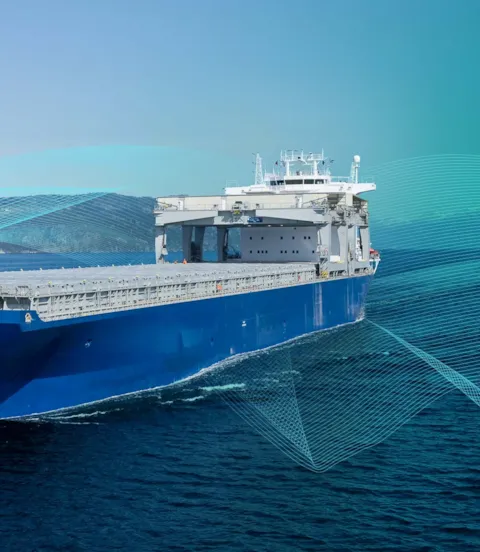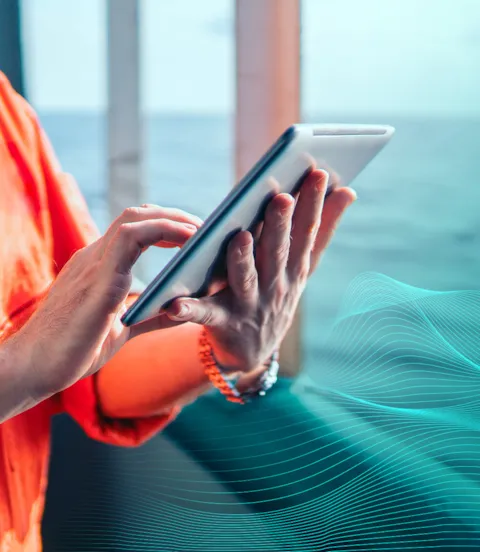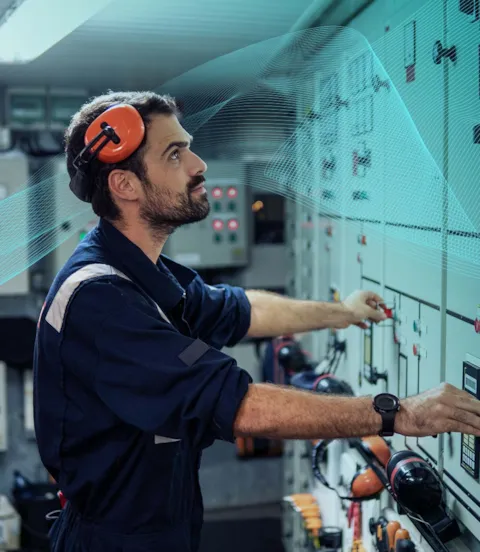Enabling transformation: DNV supports Grieg Star with digital roadmap for the future
The maritime industry must navigate a challenging course through digital transformation in pursuit of smarter, safer, more efficient and sustainable shipping. And, like any other journey, a detailed roadmap is needed to reach the destination. DNV has supported Grieg Star in developing such a map to achieve the goal of data-driven ship management.
“We see digital transformation as a vital enabler to realizing our strategic vision of green and smart world-class ship operations that are aligned with decarbonization requirements and optimized for efficiency,” says Grieg Star managing director Atle Sommer.
Grieg Star is the ship management unit of Norway’s Grieg Maritime Group and runs a fleet of 30 open-hatch vessels. All of these are a part of the G2 Ocean pool, a joint venture between Grieg Maritime Group and Gearbulk operating a fleet of close to 100 such vessels.
The company has already made big strides on its digital journey, having merged its IT division with that of Gearbulk and G2 Ocean in 2019 to accelerate the transformation process in ship management within different departments across Grieg Star and Gearbulk.

Guiding the way for smart shipping
Sommer believes the smart ship of the future will have a high level of automation enabled by digital technology with gradually increased autonomy. At the same time, Grieg Star envisages that digitalization will be an enabler for carbon-neutral fleet operations by 2050, near-100% vessel uptime and significant operating cost reductions.
“We will not be able to deliver world-class operations in five to ten years’ time unless we fully embark on the journey towards smart shipping. There is no way around it. The push for green and smart operations goes hand in hand. Green will change the technology, while smart/digital will fundamentally change the way we work. In that respect, digitalization will possibly have an even greater impact than decarbonization,” Sommer says.

Digitalization holds high savings potential
As well as the need for decarbonization, the trend towards increasingly digitalized systems is being driven by the potential for significant cost savings from emerging technologies such as an onboard internet of things using data sensors, artificial intelligence, big data and machine learning, as well as expanding cloud connectivity with wider satellite coverage and falling costs for such technologies. The COVID-19 pandemic confirmed the potential benefits for the shipping industry of digital tools for remote ways of working in areas such as crew training.
DNV’s Discipline Leader in Digital Transformation, Jan van Tiggelen, who has been working with Grieg Star on its transformation project, says: “The ability to process real-time data to gain actionable insights into operations enables more reliable decision-making to make business processes more efficient, as well as enhanced monitoring, control, quality assurance and verification. The instant availability of such data also provides transparency for improved safety and greatly eases the process of compliance reporting in regard to ESG requirements.”

Digital investment is “low-hanging fruit”
Industry studies have shown that around 15% of decarbonization gains required to meet the IMO goal to halve greenhouse gas (GHG) emissions by 2050 will come from operational efficiencies on existing ships. Data-driven measures such as energy efficiency, fuel consumption monitoring, condition monitoring for preventive maintenance, optimized weather routing and vessel performance management can contribute both to reduced emissions and operational economies. For example, a 1% saving on an annual fuel bill of $500 m for a 100-vessel fleet would amount to a $5 m saving per year.
“Optimized energy efficiency and operations through digitalization are low-hanging fruits with lower investments compared to alternative fuels and conversions. These can help the shipowner to keep the vessel GHG compliant while awaiting more mature alternative fuel technologies,” according to DNV’s Advisory department Head of Safety Øystein Goksøyr.
But, given the clear benefits in terms of environmental gains, lower costs and improved safety, why are only a few shipping companies like Grieg Star embracing the digital shift?

DNV supports industry to leverage digitalization
Goksøyr explains: “The somewhat conservative and traditional mindset of the shipping industry has slowed progress on digitalization relative to other sectors such as aviation and automotive. Digital transformation entails an overhaul of business processes and products to fully leverage the opportunities of data-driven solutions. This results in organizational changes and new ways of working, which can make it difficult to implement. In addition, there is a strong focus on 24/7 fleet operations with minimal disruption that constrains a company’s ability to transform.”
DNV has now established a digital transformation section to support the industry shift, predicated on its smart vessel class and cyber security notations for data infrastructure related to operations, maintenance and energy efficiency, as well as services such as remote surveys and electronic certificates accessible via its Veracity platform. These cover the four main areas of transformation - strategy, smart fleet transformation, management implementation and smart vessel operations.

Leadership from the top needed for transformation
Goksøyr believes active leadership, support and involvement from management to promote a collective understanding of the benefits and consequences from implementation of digital initiatives is an essential starting point for the digitalization journey. “At the same time, it is necessary to have a clear vision and long-term strategic goals to determine where you are on your journey, where you want to go and how to get there,” Goksøyr says.

Digital transformation roadmap supports finding the right strategy
In the case of Grieg Star, DNV has helped to develop a digital transformation roadmap towards 2040 that has entailed establishing strategic goals, then determining the current status in areas such as smart maintenance, energy management and safety, and assessing the gap between where things are at now and the company’s long-term ambition. The roadmap is then used to plot the way forward by identifying action areas and a timeline for the application of digital solutions, including remote inspections, energy management, automated MRV and DCS reporting for the EU and IMO, respectively, and predictive maintenance.
“Our aim has been to revisit our long-term objectives, establish the status of ongoing digital initiatives, make priorities, and ensure we are on the right track and that everything we do takes us in the same direction. With DNV’s wider industry insight, we have gained a precise overview of our current status and are more on the same page internally. We now have a roadmap to give us a clear sense of direction that means we can start walking and step-by-step realize the potential of digitalization,” Sommer emphasizes.

Data-driven ship management enables centralization
According to van Tiggelen, DNV and Grieg Star have together identified use cases for pilot projects that can be tested and implemented at low cost, such as a KPI dashboard tool for centralized performance and drydocking application, in addition to ongoing digitalization initiatives including upgrades to existing systems and replacement of legacy software. Centralization of fleet operations is one of the main strategic goals of Grieg Star, along with emissions and cost reductions, and is seen as a key element in the shift to data-driven ship management.
Grieg Star envisages that in future automated real-time data from smart ships will facilitate fleet management based on data analysis for performance benchmarking by constantly tracking all vessels over time. This enables optimized fleet-wide decision-making, leading to improvements in cost, efficiency and safety. For example, such a solution will be able to see whether a ship is running multiple auxiliary engines at low load, leading to increased fuel use and running hours, and can give corrective guidance to save emissions and maintenance costs.

Holistic approach with humans onboard for change
G2 Ocean’s Vice President for IT, Kristin Andersen, points out the initial initiatives at Grieg Star have been focused on replacing legacy software, creating new integrated digital infrastructure and moving from dashboards to analytics. “You need to walk before you can run. There is a stairway to heaven for autonomous vessels and we need to do a lot to get there. The right technology has to be in place for when such ships are ready,” she says.
Andersen says mature technology for remote control of ship operations is already available but “can only be implemented effectively based on a holistic approach together with processes and people”. She highlights the importance of the human element in the transformation process so that crew onboard vessels are not burdened with a higher digital workload in addition to manual tasks, but rather that administrative tasks such as compliance reporting are automated and transferred to shore so ship personnel can work more effectively in their assigned roles.
“The biggest challenge in changing ways of working is not the technology but the human element. Change management is necessary to ensure employees are onboard the transformation process and to develop a common sense of ownership. Having a roadmap enables us to carry out that process in a stepwise manner – and this makes the journey to smart shipping more interesting for everyone,” Sommer concludes.

- Grieg Star, Web shape vector created by GarryKillian - www.freepik.com
- Grieg Star
- Shutterstock / Kardasov Films, Electric wave vector created by rawpixel.com - www.freepik.com
- DNV